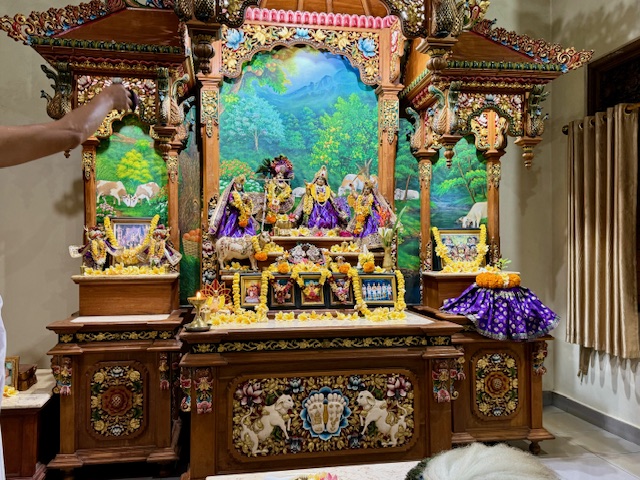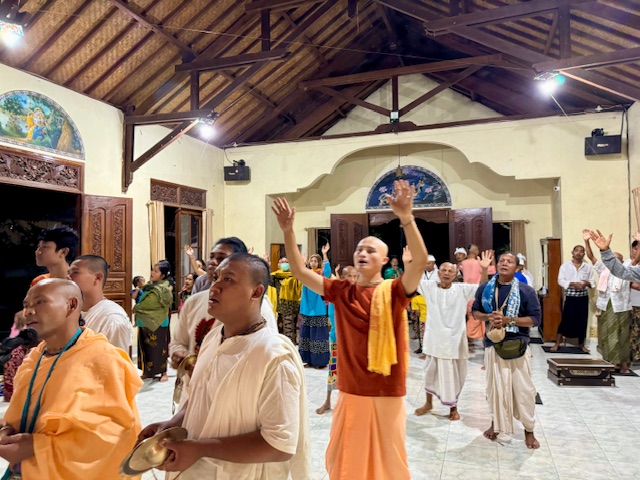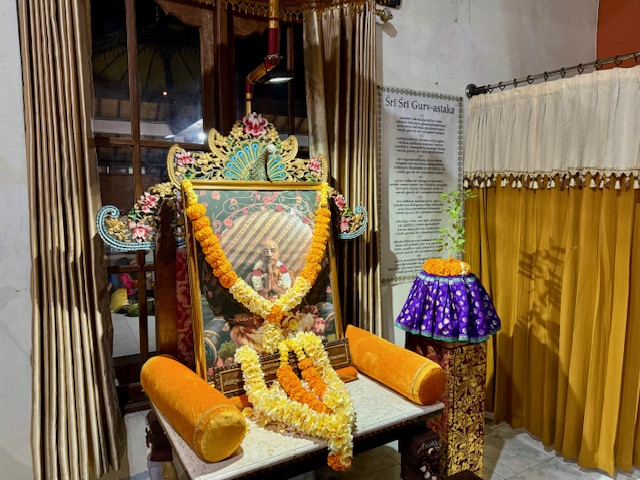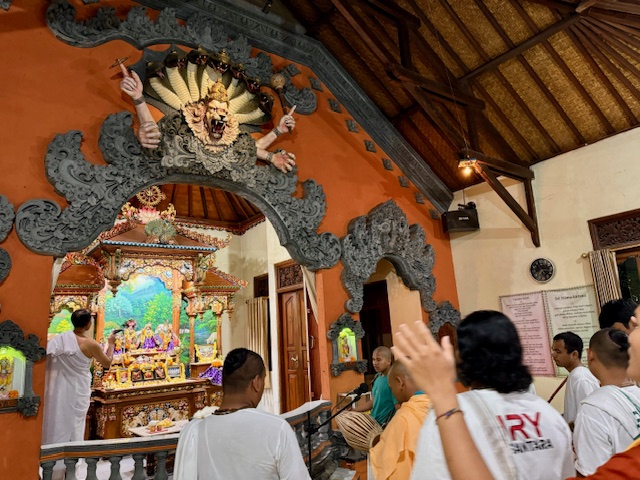Are Varna And Ashrama The Only Two Hierarchies Present In Nature
Do People Of Particular Skin Colors Belong To Particular Castes
→ The Spiritual Scientist
Does Racism Exist Because Of The Caste System
→ The Spiritual Scientist
From A Spiritual Perspective Why Does Racism Exist
→ The Spiritual Scientist
“Books are the Basis” Global Celebration to be Held in September
→ ISKCON News
The ISKCON Ministry of Education is delighted to announce this year’s “Books Are The Basis” week. This global celebration will be held from September 18th to 24th to commemorate the significance of Srila Prabhupada’s arrival in America. In the spring of 2020, the GBC Body passed a resolution encouraging all ISKCON centres to emphasize the […]
The post “Books are the Basis” Global Celebration to be Held in September appeared first on ISKCON News.
Srila Prabhupada International Heritage Museum Set to Open in 2025
→ ISKCON News
The Srila Prabhupada International Heritage Museum, under the guidance of TOVP Chairman Ambarisa Das and Svaha Dasi, will be constructed in three phases. The first phase will cover 1,000 square feet and will open on February 18, 2025, during the International Leadership Sanga (ILS). The second phase will expand to 6,000 square feet, and the […]
The post Srila Prabhupada International Heritage Museum Set to Open in 2025 appeared first on ISKCON News.
Sri Sri Radha Madhava Gianyar Bali
→ Ramai Swami


Many years ago, our function in the Gianyar region of Bali was held in Pradhyumna Prabhu’s house. A downstairs room served as the temple and we were graced with small Gaura Nitai deities. It was a remote location in the middle of crop fields and in the rainy season all of us had to hike up our dhotis to get through the mud.
By the mercy of Their Lordships, the current temple, which is nearby the original, is a sizable acreage. It has a grand temple building, asrama, guest house, plus small goshala. The devotees own houses around the temple complex. Their Lordships, Sri Sri Radha Madhava, Lalita, Visakha, and Gaura Nitai have a beautiful altar and are served enthusiastically.


Revitalizing ISKCON: A Call to Reconnect with Srila Prabhupada’s Vision
→ ISKCON News
The Prabhupada Network Team, under the leadership of Janmastami Dasa, successfully organized three Srila Prabhupada Connect Day events from July 27-28, 2024 in Sri Mayapur Dham. The events were designed to commemorate the 58th anniversary of ISKCON’s incorporation, highlight ISKCON’s transcendentally conceived seven purposes, and strengthen the community’s connection with Srila Prabhupada as our Founder-Acarya. […]
The post Revitalizing ISKCON: A Call to Reconnect with Srila Prabhupada’s Vision appeared first on ISKCON News.
ISKCON Trivandrum Sharing Prasadam and Supplies to Thousands of Kerala Victims
→ ISKCON News
Destructive and deadly landslides and widespread flooding from torrential rains have killed hundreds and left thousands homeless in southern India’s Kerala state. ISKCON Trivandrum immediately began taking action to supply both essentials items and packed prasadam to those affected by the devastations. Jagat Sakshi Dasa from ISKCON Trivandrum released the following statement on August 7, […]
The post ISKCON Trivandrum Sharing Prasadam and Supplies to Thousands of Kerala Victims appeared first on ISKCON News.
Report of ISKCON Russian speaking Yatra for the month of July
→ Dandavats
Read More...
Celebrities visit Iskcon Mumbai and get Srila Prabhupada’s books
→ Dandavats
When Yudhishthira Considered Duryodhana A Good King Was Killing Him Necessary To Establish Dharma
→ The Spiritual Scientist
Chaitanya Charan on Amogha Lila P’s podcast, My spiritual journey-Science, Writing, Western outreach
→ The Spiritual Scientist
Bhagavad Gita Overview, Chapter 5
→ The Spiritual Scientist
When Achievements Feel Pointless – Gita Verses 15 Gita 2.8 – 2.10 #gitaverses #gitaversebyverse
→ The Spiritual Scientist
Arjunas Universal Question – Gita Verses 14 Gita 2.07#gitaversebyverse
→ The Spiritual Scientist
Arjunas Counter Argument And Confusion- Gita Verses 13 Gita 2.4 – 2.6
→ The Spiritual Scientist
Krishna Infers Arjunas Motivation- Gita Verses 12 Gita 2.1 – 2.3
→ The Spiritual Scientist
Arjunas Qualification For Hearing Gita Wisdom- Gita Verses 11 Gita 1.44 – 46
→ The Spiritual Scientist
Arjuna Far Sighted But Not Far Sighted Enough – Gita Verses 10 Gita 1.41 – 43
→ The Spiritual Scientist
IT Hub Turns Devotional as ISKCON Gurugram Hosts Eleven Rathayatras Across City
→ ISKCON News
Residents of Gurugram, the IT capital of India, recently had a unique opportunity to experience and immerse themselves in devotional culture. From July 6th to 15th, eleven Rathayatras were organized in different parts of Gurugram. Scores of people from all age groups and different strata of society participated in the festival. Gurugram is considered the […]
The post IT Hub Turns Devotional as ISKCON Gurugram Hosts Eleven Rathayatras Across City appeared first on ISKCON News.
Dublin Ratha Yatra 2024 (Our biggest to date)
→ Dandavats
Read More...
Arjuna Foresees Social Disaster – Gita Verses 9 Chapter 1 Verses 37 – 40
→ The Spiritual Scientist
Arjunas Cost Benefit Analysis Gita Verses 8 Chapter 1 Verses 31 – 36
→ The Spiritual Scientist
Arjunas Unbearable Agony- Gita Verses 7 Chapter 1 Verses 26 – 30
→ The Spiritual Scientist
The Pandavas Morale Goes Up Down- Gita Verses 6 Chapter 1 Verses 15 – 25
→ The Spiritual Scientist
Krishnas Disarming Introduction – Gita Verses 5 Chapter 1 Verse 14
→ The Spiritual Scientist
The Mind Games End And War Begins – Gita Verses 4 C1 V10to13
→ The Spiritual Scientist
India’s IT Capital gets taste of devotional culture through 11 Rath Yatras
→ Dandavats
Read More...
Books Are The Basis Week 2024
→ Dandavats
Read More...
Duryodhanas Vision Points To His Disposition – Gita Verses 3 C1 V5 To 9
→ The Spiritual Scientist
How To Be Spiritually Situated Gita 3 43
→ The Spiritual Scientist
Duryodhana Unaffected By Place Of Dharma – Gita Verses 2 1.2 To 1.4
→ The Spiritual Scientist
How Boundaries Protect Us Gita 3.41
→ The Spiritual Scientist
Inner Hierarchy Gita 3.42
→ The Spiritual Scientist
UK Gurukula Wins Social Impact Award
→ ISKCON News
The award given to the UK Gurukula; Gunacuda Dasi, the Headteacher. The UK Gurukula, also known as the Hare Krishna Primary School, received a 2024 Social Impact Schools Award this summer. These awards recognize schools and their students for having a positive impact on the world. Based on students at any school executing social action […]
The post UK Gurukula Wins Social Impact Award appeared first on ISKCON News.